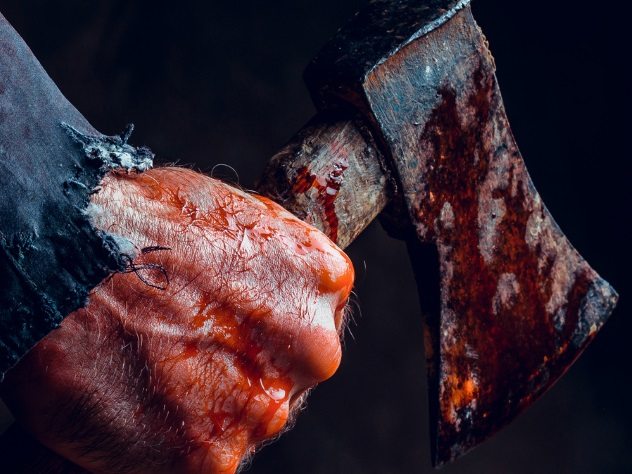There is no telling why some murderers feel the need to hide their victims when, as history shows us, many bodies are discovered, and their murderers are eventually caught. The victims on this list were no exception. However, the gruesome acts perpetrated on their bodies were the stuff of nightmares.
10 Her Son Was Close By
Out of London, in 1946, came the news of a mother’s terrible loss. Mrs. Berresford owned a home and rented rooms out to lodgers. Her son, Harry, was a 19-year-old soldier. One day, Harry stopped by his mother’s home, and he met Sheminant, a lodger who seemed to think he was king of Mrs. Berresford’s house. There must have been some dispute because Harry was never seen alive again. After some time passed, Harry was listed as a deserter, but his mother could scarcely believe it. Maybe he was hiding in his bedroom, she thought. After all, her lodger, Sheminant, kept her son’s bedroom door locked and prevented her from entering it. After two months had passed, Mrs. Berresford forced the bedroom door open. She could not see her son in the room, but she did see a loose floorboard. She lifted the floorboard and put her hand inside. She thought he felt a knee, but she wasn’t sure. The mother revisited the room several more times and began to notice a “disagreeable smell.” She finally realized the awful truth and informed the police. Sheminant was arrested, charged with murder, and sent to trial.[1]
9 Neatly Cut And Wrapped
In the early 20th century, when a woman committed murder, it was a shocking event because most people felt that a woman couldn’t commit such a heinous crime. In 1915, Mrs. Mary Pamais allowed a crippled peddler into her apartment while her husband was away. The peddler, Michael Weinstein, threatened to reveal to her husband some very personal letters she had written, and it was enough to send her into a panic and murder the man. Normally, when someone commits a murder, they either go on the run, or they get rid of the body. Mrs. Pamais did neither. Instead, she dragged the body into her bedroom and stuffed it in the box couch. That night, after her husband returned home, they both slept in the bedroom where the body was hidden. The next day, while her husband was out of the apartment, Mrs. Pamais pulled the body out of the box couch. She then proceeded to chop the corpse up into little pieces, wrap each piece neatly in newspaper, and place them back into the box couch. Being ever busy, Mrs. Pamais rented a new apartment that same day and arranged for a new trunk to be delivered so that she could move the body parts. The only problem was that she wanted to make a run for it, and she told her husband what she had done that night. Being, apparently, a good man, her husband spent the rest of the night begging her to surrender to the police. By day three, she was in the police station and had confessed to all the gruesome details.[2]
8 In The Cupboard
Dr. Pierre Bougrat had a medical practice in Marseilles, France, back in 1925, and by all outward appearances, he seemed to be an upstanding citizen until his money problems got the best of him. First, the doctor cheated on his wife and eventually divorced her, the daughter of another doctor, for another woman. As with almost all new marriages, things were great at first, but their spending habits exceeded his income, and soon, he was accused of writing bad checks. At his practice, there were other weird things happening. For example, one of his patients, a young man named Jacques Rumede, stopped by to visit him and was never seen again. Another patient, a woman, came forward and claimed that the doctor had tried to poison her after she had lent him a sizable amount of money. As suspicions began to reach the ears of the police, officers went to arrest Dr. Bougrat for writing a series of bad checks. With him in their custody, they searched his office. Nothing seemed out of order, except for the strange damp spot along one of the walls. Curiosity was piqued, and the police stripped the wallpaper back to discover a hidden cupboard. They opened it, and out fell the body of young Jacques Rumede. The young man’s wallet, said to have contained a large sum of cash, was missing. The doctor, of course, had an excuse for the body in the cupboard. He claimed the young man had come to him, worried about having lost a large sum of money: “He asked me to lend him the money. [ . . . ] I did my best to calm him, and left the surgery for a few minutes, and when I came back he was dead . . . I was afraid I would be accused of his murder, so I hid the body in the cupboard, which I papered over.” Dr. Bougrat was arrested. As he awaited trial, the police found evidence that he may have also murdered a cook, an American bar manager, and a hospital nurse.[3]
7 The Telltale Stench
Fred Eschle of St. Paul, Minnesota, was a drunk and an ex-convict. He also couldn’t survive without stealing from others, and one day, he found himself the perfect victim. Fred met and murdered a St. Paul ragpicker inside the victim’s shack in 1908, blowing off the top of his head with a shotgun. It was alleged that Fred took $70 from the victim’s pocket, and then he buried the body under the shack’s floorboards. Without skipping a beat, Fred made himself right at home. He ate the victim’s food and slept in his shack with the dead body beneath his feet. Before long, people became suspicious, and while Fred was out, the police raided the home and discovered the victim’s body. Fred was captured and confessed to the murder, claiming that he could not be held fully responsible for the murder because he was drunk. When asked about the money, Fred said it did him little good. A pickpocket stole the money shortly after the murder while Fred was, again, drunk.[4]
6 Molten Lead
Pierre Voirbo was known by his acquaintances to be a bit of an oddball, but they never expected there was a monster within the man until 1869. Voirbo needed money, as always, and borrowed a large sum from Mr. Bodasse. Knowing that he could not pay the old man back, he did the next best thing. Voirbo invited Bodasse over to his Paris apartment for coffee. Upon Bodasse’s arrival, Voirbo hit him with a flat iron and cut his throat. He then dissected the body and dumped some of the parts into a nearby well. In an effort to prevent the police from ever identifying Bodasse, Voirbo took the decapitated head and poured molten lead into the mouth and ears. He later sank the head to the bottom of the Seine. Fortunately, Voirbo was discovered and confessed to his gruesome crime. It was believed that he may have committed ten previous murders as well, but it was never thoroughly proven. Voirbo, while awaiting trial, managed to slit his own throat using a knife that had been hidden inside a loaf of bread.[5]
5 Self-Defense?
The police searched for Mrs. Winnie Ruth Judd for five days following the discovery of two women she was accused of murdering back in 1931. Unbeknownst to the authorities, she was hiding among the coffins in an undertaker’s establishment until, starved and frightened, she decided to turn herself in to the Los Angeles police. According to Mrs. Judd, she had gotten into an argument with her friends after a night of partying. One of the women pulled out a gun and shot Mrs. Judd through the hand. She wrestled with the two women and got the gun away from them. At that point, she shot them both. Mrs. Judd, if her story was true, should have gone straight to the police at that moment, but she did not. Instead, she hacked the two women into pieces, placed them into two travel trunks, and, while wearing a disguise, booked the trunks onto the Southern Pacific railway.[6]
4 Sewn In Place
The scene outside of Dungog, New South Wales, in 1909 was unbelievable. A man had come across a bulky bag in a creek and went to check it out. After a moment of poking and prodding, he realized it was a dead body and sent for the police. The police were in for one heck of a gruesome shock. Inside cement bags that were sewn together was a blanket sewn over the body of a middle-aged man. The man wore only a flannel undershirt, and the back of his head had been smashed in with a pick. His face was a battered mess, and his jaw was broken. As if that weren’t enough to kill a man, the victim’s throat had been sliced ear-to-ear. His arms and legs were mutilated, and the bones were broken so that the body could be doubled up and sewn into the blanket and bags. It took a bit of time, but the victim was eventually identified as a local laborer. Interviews with potential witnesses led the police to the alleged murderer.[7]
3 Left In A Cloakroom
In 1924, Charles Travis, age 21, was an American on vacation with his wife in London. They had their ten-month-old son with them, but the young couple were not fit for the duties of parents. The child, Dean, cried quite often during the night while they were in London. A doctor was called in, and the father insisted the baby had scarlet fever, but the doctor assured him that his son was healthy and merely had some mild skin irritation. For another three weeks, the child would cry at night, as most young children do, but the father had had enough of it. One night, Charles awoke to the crying, got out of bed, and went into the child’s room. Looking down upon his son, he placed his hand over the child’s mouth, squeezed his nose shut, and pressed down on his windpipe until the child ceased to breathe. The next morning, Charles put the child’s body into a kitbag and left on a train to Birmingham, where he dropped the bag off at a cloakroom, gave a false name, and returned by train to London. Later that evening, Charles sent a telegram to his parents stating that his son had died from scarlet fever. Meanwhile, the landlady of the place they were staying at became suspicious when she no longer heard the baby crying. The police were brought in and questioned the parents, who claimed that the infant was being cared for by some friends. However, the inspector was not a very trusting man, and eventually, he got Charles to confess to murder. Charles was arrested and sent to trial. He was found not guilty on the murder charge but was convicted and sentenced to five years’ penal servitude for manslaughter.[8]
2 Bagged
After committing a murder, some killers will go the extra mile, or many miles, just to get rid of the body, such as in a case in 1905 when human remains were discovered in an irrigation channel. Mr. Crawford, a channel guard, was making his rounds one day and walked along the banks of a channel in Girgarree, Victoria. He noticed a bran bag in the water and went to check it out. On opening the bag, he discovered the body parts of a human being, and the police were immediately contacted. The police uncovered a terrible sight. The torso was dressed in two shirts and disemboweled, the head was cut off, and both of the victim’s legs had been cut off at the thighs. It was determined that the body parts had been in the water for about two months. Being that it was 1905, there was no way to identify the body, and it was assumed that it may have been a former resident from Waranga Basin. The case was just another mystery death, and the remains were sent to the local coroner.[9]
1 First He Whacked Her With A Hammer
Have you ever dealt with someone who was so annoying that you pictured yourself doing some sort of bodily harm to that person? We all have those little dark fantasies now and again, but James Hazelton followed through with his urge back in 1909. Mr. Hazelton and his wife got into an argument in their home in New Haven, Connecticut. It was a stupid argument, like most, but then his wife began dredging up past offenses, and Hazelton could take no more of it. He grabbed a hammer and hit her over the head with it. She collapsed, and while she was blacked out, he grabbed a knife and stabbed her. After he was certain that she was dead, Mr. Hazelton stuffed her body in a large trunk, which he then slept on top of for several nights. Finally, he threw a quilt over the top of the trunk and went on the run. After being captured in New York City, Mr. Hazelton confessed to his crime, saying, “Yes, I killed her because we could not get along together.”[10] Elizabeth lives in the beautiful state of Massachusetts where she is currently involved in researching early American history. She writes and travels in her spare time.
























